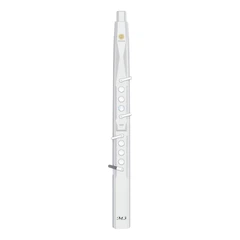An Electronic Wind Instrument (EWI Electronic Wind Instrument) is a sophisticated musical device that combines the playing techniques of traditional wind instruments with modern electronic technology. Here's a detailed explanation of how an EWI Electronic Wind Instrument works:
Components and Functionality
Mouthpiece and Breath Sensor:
Mouthpiece: The player blows into the mouthpiece, similar to a traditional wind instrument.
Breath Sensor: Inside the mouthpiece, there is a breath sensor that detects the air pressure and converts it into an electronic signal. This signal is used to control the volume and dynamics of the sound produced.
Finger Sensors:
Touch-Sensitive Keys: The EWI Electronic Wind Instrument has touch-sensitive keys or pads that detect the player's finger positions. These keys are often arranged in a layout similar to that of a saxophone or other wind instruments.
Pitch Control: The finger sensors determine the pitch of the notes being played. Some models also have additional sensors for pitch bending and vibrato effects.
Control Interface:
Buttons and Knobs: EWI Electronic Wind Instruments typically have various buttons and knobs for adjusting settings such as breath sensitivity, pitch, and sound selection.
Display Screen: Some models include a display screen to show current settings and other information.
Sound Generation:
Built-in Sound Module: Many EWI Electronic Wind Instruments come with a built-in sound module that generates the sound based on the input from the breath and finger sensors. This module can produce a wide range of sounds, from traditional wind instruments to synthesized tones.
External Sound Module: EWI Electronic Wind Instruments can also be connected to external sound modules, synthesizers, or computers via MIDI or USB to access additional sounds and effects.
Connectivity:
MIDI/USB Ports: These ports allow the EWI Electronic Wind Instrument to be connected to other MIDI-compatible devices, computers, or digital audio workstations (DAWs) for recording, sound editing, and live performance.
Headphone Jack: For silent practice, players can connect headphones directly to the EWI Electronic Wind Instrument.
Wireless Options: Some modern EWI Electronic Wind Instruments offer wireless connectivity options for greater mobility during performances.
How It All Comes Together
Playing the EWI Electronic Wind Instrument:
The player blows into the mouthpiece, and the breath sensor detects the air pressure.
The player uses their fingers to press the touch-sensitive keys, which determine the pitch and other aspects of the sound.
Signal Processing:
The breath and finger inputs are converted into electronic signals.
These signals are processed by the EWI Electronic Wind Instrument's internal circuitry to control the sound generation.
Sound Production:
The processed signals are sent to the built-in sound module or an external device to produce the desired sound.
The sound can be heard through built-in speakers, headphones, or an external amplifier.
Example Workflow
Setup:
Connect the EWI Electronic Wind Instrument to a power source or insert batteries.
Adjust the breath sensitivity and other settings to suit your playing style.
Playing:
Blow into the mouthpiece and use the finger keys to play notes.
Use additional controls for pitch bending, vibrato, and other effects.
Sound Customization:
Select different sounds or patches from the built-in sound module or an external device.
Adjust parameters like volume, reverb, and modulation to shape the sound.
Recording and Performance:
Connect the EWI Electronic Wind Instrument to a computer or DAW for recording and editing.
Use MIDI or USB connections to integrate the EWI Electronic Wind Instrument with other musical equipment for live performances.
Conclusion
The EWI Electronic Wind Instrument is a versatile and expressive instrument that leverages modern electronic technology to offer a wide range of sounds and playing possibilities. By combining traditional wind instrument techniques with advanced electronic features, the EWI Electronic Wind Instrument provides musicians with a unique and powerful tool for both practice and performance.
SUNRISE MELODY M3 Electronic Wind Instrument - The best-selling Electronic Wind Instrument
. 66 Timbres
. Built-in Speaker
. Connect Bluetooth
. Ultra-long Polymer Lithium Battery Life



